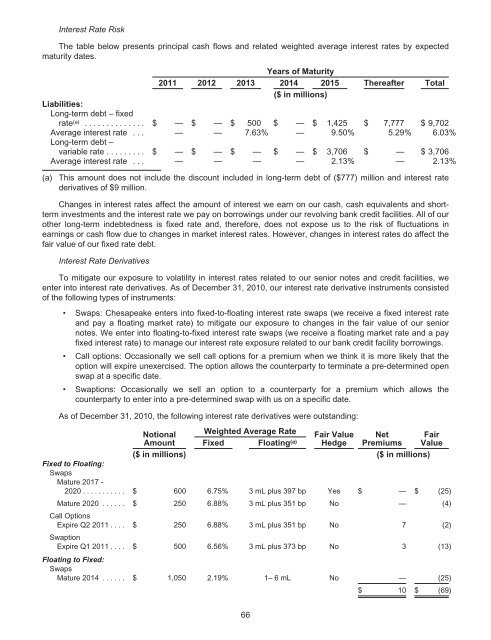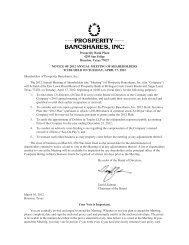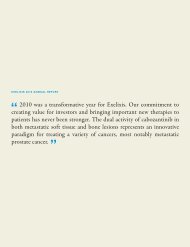6 5 - RR DONNELLEY FINANCIAL - External Home Login
6 5 - RR DONNELLEY FINANCIAL - External Home Login
6 5 - RR DONNELLEY FINANCIAL - External Home Login
Create successful ePaper yourself
Turn your PDF publications into a flip-book with our unique Google optimized e-Paper software.
Interest Rate Risk<br />
The table below presents principal cash flows and related weighted average interest rates by expected<br />
maturity dates.<br />
Years of Maturity<br />
2011 2012 2013 2014 2015 Thereafter Total<br />
($ in millions)<br />
Liabilities:<br />
Long-term debt – fixed<br />
rate (a) .............. $ — $ — $ 500 $ — $ 1,425 $ 7,777 $ 9,702<br />
Average interest rate . . .<br />
Long-term debt –<br />
— — 7.63% — 9.50% 5.29% 6.03%<br />
variable rate ......... $ — $ — $ — $ — $ 3,706 $ — $ 3,706<br />
Average interest rate . . . — — — — 2.13% — 2.13%<br />
(a) This amount does not include the discount included in long-term debt of ($777) million and interest rate<br />
derivatives of $9 million.<br />
Changes in interest rates affect the amount of interest we earn on our cash, cash equivalents and shortterm<br />
investments and the interest rate we pay on borrowings under our revolving bank credit facilities. All of our<br />
other long-term indebtedness is fixed rate and, therefore, does not expose us to the risk of fluctuations in<br />
earnings or cash flow due to changes in market interest rates. However, changes in interest rates do affect the<br />
fair value of our fixed rate debt.<br />
Interest Rate Derivatives<br />
To mitigate our exposure to volatility in interest rates related to our senior notes and credit facilities, we<br />
enter into interest rate derivatives. As of December 31, 2010, our interest rate derivative instruments consisted<br />
of the following types of instruments:<br />
Swaps: Chesapeake enters into fixed-to-floating interest rate swaps (we receive a fixed interest rate<br />
and pay a floating market rate) to mitigate our exposure to changes in the fair value of our senior<br />
notes. We enter into floating-to-fixed interest rate swaps (we receive a floating market rate and a pay<br />
fixed interest rate) to manage our interest rate exposure related to our bank credit facility borrowings.<br />
Call options: Occasionally we sell call options for a premium when we think it is more likely that the<br />
option will expire unexercised. The option allows the counterparty to terminate a pre-determined open<br />
swap at a specific date.<br />
Swaptions: Occasionally we sell an option to a counterparty for a premium which allows the<br />
counterparty to enter into a pre-determined swap with us on a specific date.<br />
As of December 31, 2010, the following interest rate derivatives were outstanding:<br />
Notional<br />
Weighted Average Rate<br />
Fair Value Net Fair<br />
Amount Fixed Floating Hedge Premiums Value<br />
(a)<br />
($ in millions) ($ in millions)<br />
Fixed to Floating:<br />
Swaps<br />
Mature 2017 -<br />
2020 ........... $ 600 6.75% 3 mL plus 397 bp Yes $ — $ (25)<br />
Mature 2020 ......<br />
Call Options<br />
$ 250 6.88% 3 mL plus 351 bp No — (4)<br />
Expire Q2 2011 ....<br />
Swaption<br />
$ 250 6.88% 3 mL plus 351 bp No 7 (2)<br />
Expire Q1 2011 ....<br />
Floating to Fixed:<br />
Swaps<br />
$ 500 6.56% 3 mL plus 373 bp No 3 (13)<br />
Mature 2014 ...... $ 1,050 2.19% 1– 6 mL No — (25)<br />
66<br />
$ 10 $ (69)











